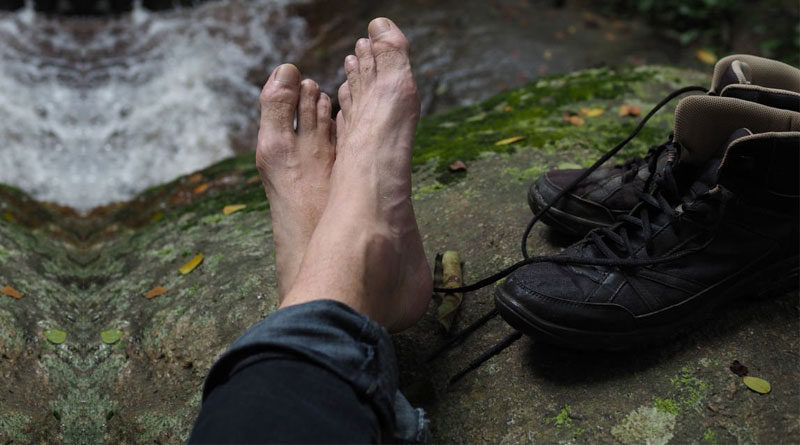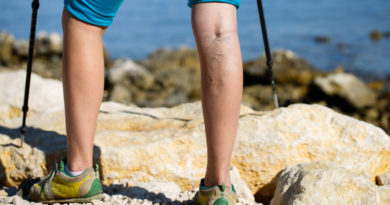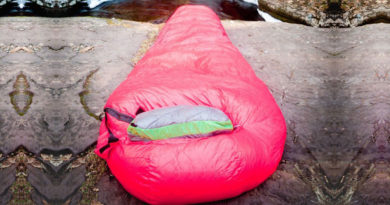Hiking Boots Too Tight? Here’s what to Do
A good pair of hiking boots or shoes should fit snugly around your foot. It is not supposed to be too tight or too loose. Consider how shoes fit along a continuum (painful, tight, snug, loose). Keep in mind that there are some situations where you need a little room in your boots. For example, when you hike for longer periods, your feet tend to swell. Also, you may need to wear thicker socks in colder months to stay warm. That being said, a boot that is tight, will be horrible to wear even for shorter hikes. Last but not least, a boot that doesn’t fit you well is going to give you blisters.
In this article, I will show you how to deal effectively with tighter boots. So keep reading to learn more.
Importance of a proper fit
A pair of boots that don’t fit you will ruin your hiking experience on the trail. Fit is one of the most important factors when choosing a pair of boots. Since you will be carrying heavy loads, your boots should be comfortable so you can hike more miles. If your boots are too tight, it will cause swelling in the feet and legs. That’s because a tighter fit will restrict blood flow in feet causing swelling. A loose-fitting boot, on the other hand, will rub against your feet giving you blisters. Blisters are painful and can ruin your hiking experience. Learn how to deal with blisters in this article here. That’s why a well-fitted pair of boots is very important for an enjoyable hiking experience.
Signs your boots are too tight
Before you can deal with tighter boots, you must first determine whether your boots are tighter or not. Below are a few signs that will tell you the fit of your boots or shoes:
- You are feeling discomfort or pain in the toes or heel
- You feel difficulty wiggling your toes
- You feel pressure or pinching in specific areas of the foot
- The boot is giving you blisters
- While hiking or climbing, the boots feel tight or restrictive
If you are experiencing any of these signs, chances are you are boots are too tight. Below I have discussed in detail how to deal with tighter boots.
What causes tight hiking boots?
There are several reasons you will end up with a pair of tight hiking boots. However, the following are the most common reasons:
1. Buying the wrong size
The most common reason for tighter boots is to buy the wrong size. But the question is: why would someone buy the wrong size? Well, there are several reasons including but not limited to:
- Lack of knowledge: This one is obvious. If you don’t know anything about sizing, you will end up getting the wrong size. This could be either a large or small size. So, do your research and get yourself familiar with sizing charts before choosing your boots.
- Improper measurement of feet: Some people may not accurately measure their feet or may not consider factors such as foot swelling during hiking. If you get a pair that has more than a snug fit, you will end up with a very tight fit after hiking a few miles.
- Assuming your shoe size hasn’t changed: Your size feet can change over time. So assuming that your shoe size is the same as it was years ago can lead to the wrong size being purchased.
- Ignoring personal foot shape: Every person’s foot shape is unique and requires different sizes and shapes of shoes. For example, if you have wide feet you are getting normal-width boots; you will end up getting tighter boots.
- Brand differences: Different brands have different sizing standards, thus even if someone knows their shoe size, switching brands may result in them receiving the incorrect size.
There are some other reasons people may end up getting the wrong size. These include unfamiliarity with a hiking-specific fit, not trying on boots before buying, and budget considerations.
2. Wearing thick socks
You bought a perfect-fitting pair of boots but you happen to wear a pair of thick hiking socks. Guess what? Your boots will be tighter than you think. This also happens when you try to wear multiple pairs of socks in winter to keep your feet warm. So, it is important to understand the importance of wearing socks with your boots. When buying your boots, you should also consider the pair of socks you will be wearing on the trail. Your boots should allow enough room for your socks so can still get a proper fit even with thicker or multiple pairs of socks.
3. Not considering the break-in period
Some leather hiking boots require a very long break-in period. So, at first, your boots may feel tight but after a few miles, you will start feeling comfortable. This is only true if you have bought the right size. You can also break your boots in before heading to the trail. Just wear them and walk in them around town for a couple of weeks. That way, your feet will start to get familiar with your boots and you will have a much more comfortable and enjoyable hiking experience when you wear them out on the trail.
4. Lacing techniques
Lacing your hiking boots with the proper technique is important for getting the right fit. The way the boots are laced can have an impact on the fit, and altering the lacing can occasionally relieve pressure and tightness. Following are a few lacing techniques that can help you relieve some tightness:
- Lacing from the bottom: It allows you to alter the fit in different parts of the foot by starting at the bottom eyelets and working your way up.
- Heel lock lacing: Tightening the laces around the ankles locks the heel in place, avoiding sliding and blisters.
- Lacing for wider feet: Skipping an eyelet or employing a ladder-lock lacing technique can give you extra leeway in the forefoot.
- Lacing for narrow feet: Tightening the laces in the mid-foot and ankle areas can help secure and prevent slippage of a thin foot.
You may discover the optimum fit for your feet and improve the comfort and performance of your hiking boots by experimenting with different lacing techniques.
Consequences of wearing tight hiking boots
There are consequences of wearing tight hiking boots. The following are the most common:
1. Foot pain and discomfort
A tighter boot can cause discomfort for obvious reasons and this discomfort feeling can lead to serious pain after a few miles. This pain can also cause the development of disorders like plantar fasciitis, Morton’s neuroma, and other foot problems over time. To avoid pain and discomfort, make sure your hiking boots fit properly and don’t place too much pressure on specific parts of your foot.
2. Blisters
Like a loose-fitting boot, a tight-fitting boot can also give you blisters. They can be very painful and can make it impossible to wear boots, causing discomfort and limiting one’s ability to hike or engage in other outdoor activities. Furthermore, if blisters are not adequately treated, they can get infected, resulting in further complications and discomfort.
3. Reduced circulation
Tight hiking boots can exert strain on the blood vessels in the feet, reducing blood flow. This can cause a number of symptoms, including cold feet, numbness, and tingling feelings. These problems, which are caused by a lack of oxygen and nutrients reaching the tissues in the feet, can be unpleasant and distracting. Restricted blood flow can also cause long-term nerve and tissue damage in the foot, potentially leading to persistent discomfort and other health issues.
4. Decreased performance
When hiking boots are excessively tight, the normal range of motion of the foot is restricted, making it impossible to move freely and comfortably. This can reduce overall performance and make hiking, walking, and other outdoor activities more difficult. Furthermore, tight boots can reduce stability and make proper balance and control more difficult. This can increase the danger of falling and injury. Tight boots can hinder the ability of the foot to react quickly and efficiently to changes in terrain, increasing the risk of injury.
5. Nail and toenail damage
Tight boots can cause the toenails to become ingrown, which means they grow into the surrounding skin, causing pain and discomfort. Ingrown toenails can potentially become infected, causing extra complications. Tight boots can also put pressure on the tips of the toes, causing damage to the toenails, which can be unpleasant and ugly. To avoid these problems, make sure your hiking boots fit properly and don’t exert too much pressure on your toes and toenails. Proper fit will assist to avoid toenail damage and lower the incidence of ingrown toenails and other foot disorders.
How to deal with tight-fitting hiking boots?
If you have a pair of tight-fitting hiking boots, there are several steps you can take to make them more comfortable:
1. Break them in
Breaking in hiking boots is essential for ensuring that they fit properly and perform well. Here are some tips to help you break in your hiking boots:
- Wear them around the house: Start by wearing the boots around the house for a few hours each day to gradually soften the material and get used to the fit.
- Walk on flat surfaces: Before using the boots on more difficult terrain, walk on flat surfaces such as sidewalks or interior surfaces.
- Gradually increase the distance: Gradually increase the distance you walk in the boots as they get more comfortable.
- Wear them with thick socks: Thick socks can assist relieve strain on specific parts of the foot and make boots more comfortable. Keep in mind that thick socks can make your boots even tighter as mentioned earlier.
- Walk on uneven surfaces: As you continue to break in the boots, start to walk on more challenging terrain, such as hills, rocks, and gravel, to get used to the boots and their fit.
- Be patient: Breaking in hiking boots takes time, so be patient and don’t push yourself too hard too soon.
Breaking in your hiking boots is critical to ensuring that they fit and perform effectively. By gradually increasing the time you spend in the boots and exposing them to a variety of terrains, you will break the easily for your next hike or outdoor adventure.
2. Use insoles
By giving cushioning and support to the foot, insoles can help make hiking footwear more comfortable. Here are some tips for making your hiking boots more comfortable with insoles:
- Choose the right type of insole: There are many different types of insoles available, including insoles designed for hiking and backpacking. Choose an insole that’s appropriate for your level of activity and the type of hiking you plan to do.
- Consider custom orthotics: Consider using custom orthotics to support your feet and relieve strain on specific areas if you have certain foot issues like flat feet or overpronation.
- Remove the existing insole: Remove the old insole from the boot before putting on the new one. While some hiking boots include removable insoles, others could require you to cut them out.
- Insert the insole: Put the new insole into the boot after removing the old one. Ensure that it is placed properly and that it completely fills the boot.
- Adjust the lacing: Adjust the boot’s lacing after placing the insole to achieve a good fit. You may need to tighten or loosen the lacing to accommodate the added thickness of the insole.
- Walk around: Once the laces are in place, walk about in the boots to check that the insole is in the right place and that they are comfortable.
You may make your hiking boots more comfortable and less likely to cause foot stress and injury by utilizing insoles to give cushioning and support. If your hiking boots are making you uncomfortable or hurting, or if you want to make your boots fit and function better, think about adding insoles.
3. Lace them correctly
Lacing your hiking boots correctly might help to improve their comfort and fit. You may improve the fit and comfort of your hiking boots by lacing them properly. If you’re suffering discomfort or pain in your hiking boots, or if you want to increase the performance of your boots, consider altering the lacing. Some popular lacing techniques are mentioned above. You can use these techniques to make your hiking boots more comfortable.
4. Stretch the boots
You can stretch the boots using a boot stretcher or by wearing them with thick socks and using a hair dryer to warm up the material. This will help to increase the space in the boots and make them more comfortable. Here are some tips for stretching hiking boots:
- Wear thick socks: When stretching your boots, wearing thick socks can help you stretch them more effectively. You can also fill the boots and stretch them with a boot stretcher or a pair of thick, hefty socks.
- Apply heat: Use heat to soften the material and make it easier to stretch the boots. To provide heat to the boots, use a hair dryer or a boot heater, taking care not to harm them.
- Stretch your boots with a stretching machine: If you have access to one, you can use it to stretch your boots. The machine will apply steady pressure to the boots, assisting in more effective stretching.
- Stretch the boots by hand: If you don’t have access to a stretching machine, you can stretch the boots by hand. Put the boots on and wear them around the house for a few hours, or use your feet to apply pressure to specific areas that are too tight.
- Repeat the process: Depending on the degree of tightness, you may need to repeat the stretching process several times to get the desired result. Be patient and persistent, and avoid stretching the boots too much at once, which might damage them or make them uncomfortable to wear.
Stretching your hiking boots might help to make them more comfortable and fit better. If you’re having discomfort or soreness in your hiking boots, or if you want to increase the performance of your boots, consider stretching them.
5. Try a larger size
If the boots are still too tight, try a larger size. You could possibly want to try a different brand or style that fits better. A larger-size hiking boot might occasionally help to solve a tight-fitting problem, but it is not always the remedy. A larger size boot may provide your feet more room, reducing pressure and discomfort, but it may also create sliding or instability. Furthermore, a larger boot may not provide adequate foot support, limiting performance and increasing the risk of injury.
It is critical to select a hiking boot that fits properly and provides adequate support and protection for your feet. If you’re having trouble with your hiking boots, try tightening the laces, adding insoles, or stretching the boots before going up a size. You might also want to talk to a hiking gear specialist or a podiatrist about finding the proper size and fit for your foot.
Conclusion
In conclusion, too-tight hiking boots can cause discomfort, suffering, and even injury. Tight boots can limit the range of motion and stability by restricting blood flow, putting pressure on certain parts of the foot, and limiting blood flow. To avoid these issues, buy hiking boots that fit properly and provide adequate support and protection for your feet. If your hiking boots are too small, you can try tightening the laces, utilizing insoles, stretching the boots, or going up a size. The ideal answer, though, is to take the time to choose a pair of hiking boots that fit well and are pleasant to wear on the trails. You can assure a safe and happy hiking experience by taking care of your feet.




